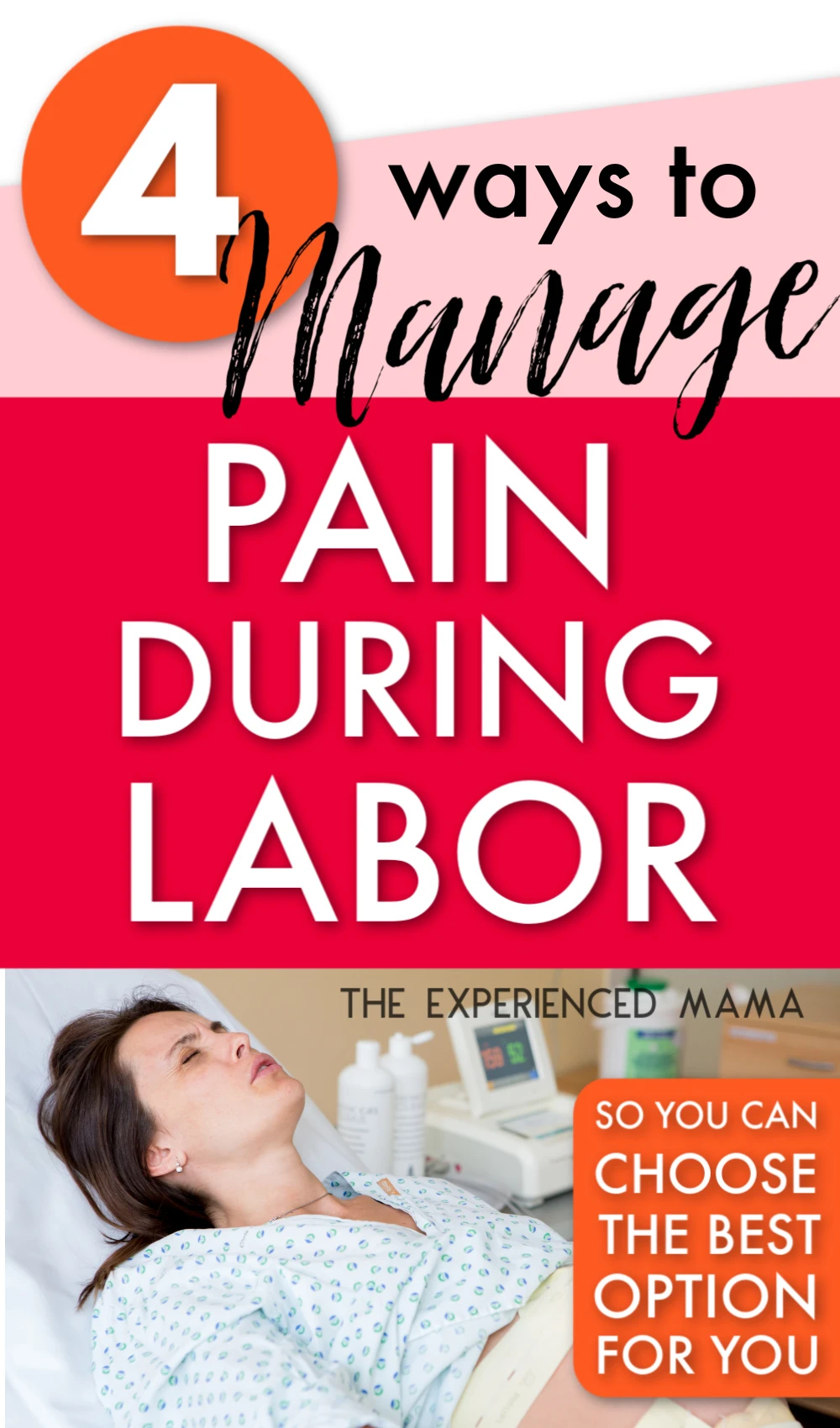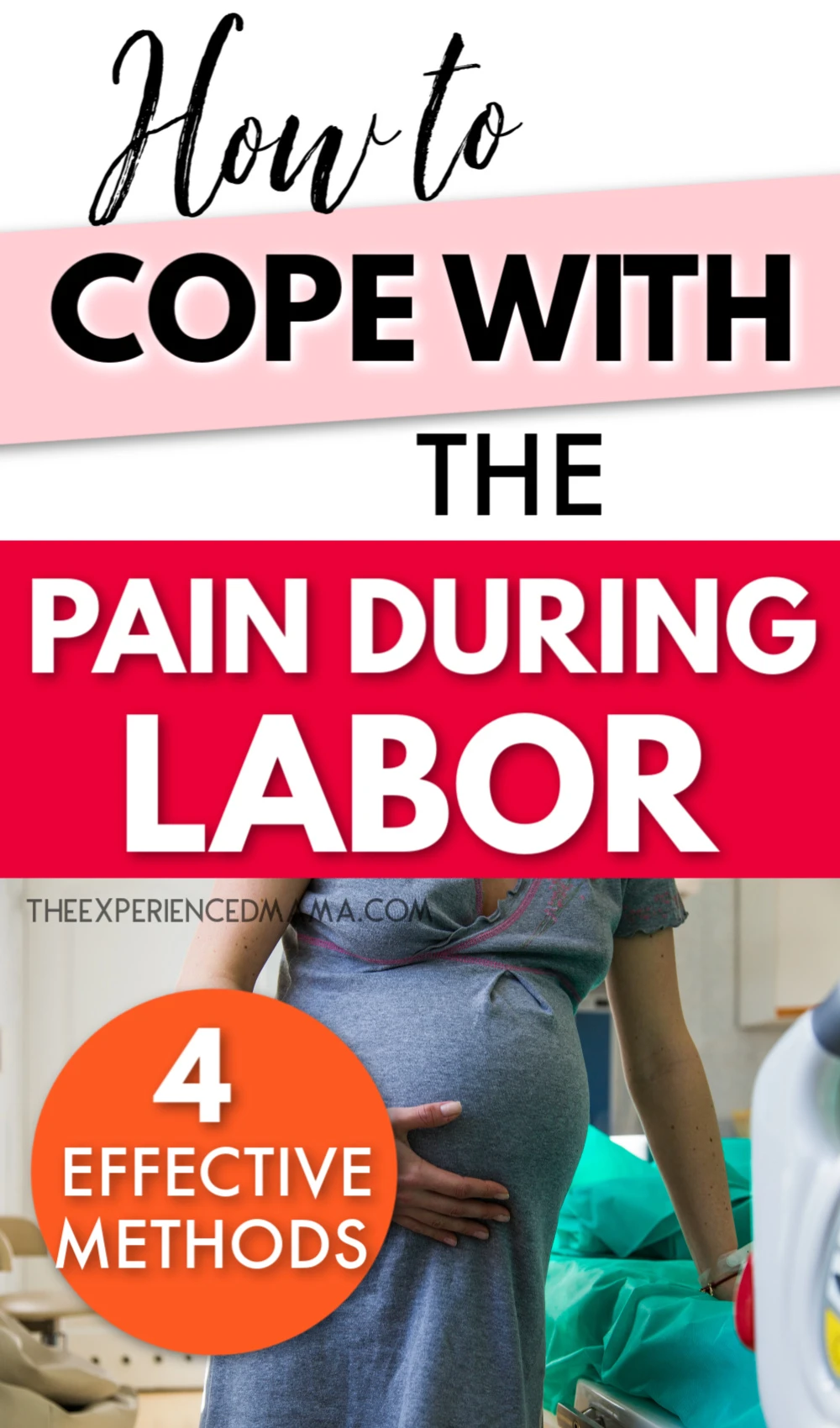Inside: Wondering how to manage pain during labor? Because you truly cannot predict how you will respond to pain during labor, nor the intensity of the pain, the best way to prepare is to learn about the four most commonly used options today.
The wonderful thing about the world around us today is that you have options in pretty much everything you do. It’s amazing to feel empowered in your medical choices!
At the same time, all those choices can often leave you looking to your left and our right at what everyone else thinks you should choose.
Decision fatigue is real, y’all, and when you don’t carefully research and consider all your options, it’s all too easy to get swept up into someone else’s STRONGLY opinionated choice about how to manage pain during labor.
Related: The Best Tips for Preparing Mentally for Labor

My Personal Experience with Managing Pain During Labor
THIS POST PROBABLY CONTAINS AFFILIATE LINKS. AS AN AMAZON ASSOCIATE, I EARN FROM QUALIFYING PURCHASES. YOU CAN READ OUR FULL DISCLOSURE POLICY HERE.
I was the first of my friends to have kids. But for some reason, those friends had some SUPER strong opinions about so-called “natural” childbirth (i.e. epidurals are evil and anyone who gets one is making a horrible choice).
I latched onto those opinions. But at the same time, I wasn’t well-educated about other options for pain management.
I mean, I took a childbirth class because that was the thing to do, and I think it was supposed to teach me something about using deep breathing to manage labor pain.
But when I got to the actual labor part? Whatever they did teach me was completely useless.
So for my first labor and delivery, I went into it believing that a “natural” childbirth was superior to getting an epidural. I clung to that belief even when my labor started and progressed in a completely unnatural way.
My water broke before I went into labor…and the contractions didn’t continue.
Because I got scared and went into the hospital (a very busy and big “move them along” hospital), they ended up putting me on Pitocin within a few hours in order to try to jump start labor.
Let me tell you: trying to go without pain medication during a Pitocin-induced labor was no joke.
I was completely unprepared for the intensity of the contractions. I couldn’t even catch my breath.
Only when the midwife told me that my baby was not tolerating labor well and I may need a c-section did I accept what I thought at the time to be an inferior pain management option: an epidural. I’m SO thankful I did choose the epidural because it allowed me to be awake and present, albeit slightly out of it, for my c-section five hours later.
During my second labor (my first of four total VBACs), I got “stuck” at 5 centimeters after twelve hours of labor and no sleep. I chose an epidural again and am so glad I did because my second-born came out with his hand up around his neck and I suffered an almost fourth degree tear.
But just because I chose an epidural for all five of my labors doesn’t mean you have to. An epidural is not the only option available.
I know several other moms who have used things like hypnobirthing, upright birth positions, and patterned breathing to manage pain during labor with great success!
But before I get into those options, here are several reasons why I chose to use an epidural for my own pain management during labor.
Hopefully they can help anyone asking, “Should I get an epidural during labor?”

Should I Get an Epidural During Labor? One Mom’s Opinion
After ending up with an epidural AND a c-section with my first baby, I felt like a failure. It was the complete opposite of my carefully made birth plan.
The thing about birth plans? They’re just that: plans.
Those plans are based on knowing next to nothing about how your body is going to respond to labor, the position of the baby, or how you will tolerate labor pain. You can guess how you will respond, but you just won’t know until you get there.
I see epidurals completely different after my fifth baby and fifth epidural. Based on my personal experience, here’s why I think you should at least consider getting an epidural during labor.
Please Note: I am NOT a medical professional. You should consult your midwife or obstetrician before making a final decision about how to manage your pain during labor. I am simply sharing my own experiences and what worked best for me during my five labor and deliveries.
1. When you are completely exhausted, epidurals can give you a much-needed rest AND stress relief.
All of my labors started at night. I wished every time for a morning labor, but alas, my babies all had different plans.
When you start labor at night before you get ANY sleep, and then try to labor through intense pain without sleep OR pain medication, you quickly get run-down.
I was so thankful to fall asleep immediately after receiving the epidural every single time. My body made the progress it needed while I was asleep.
I dilated several centimeters while ASLEEP. Amazing after the pain leading up to get through the first four centimeters!
The epidural gave me the rest I needed in order to progress in labor and to push when I finally reached 10 centimeters. The pushing was exhausting enough; I seriously can’t imagine doing it WITH pain.
During my first birth experience, I learned that I am absolutely terrible at relaxing when I’m in pain. I tense up and grit my teeth no matter how much I try to relax my body and embrace the pain.
Before my epidurals, the closest I came to natural pain management during labor was attempting upright birth positions by bouncing on a birthing ball (so if you’re considering an epidural-free labor, I highly recommend one!).
They helped until I got to about 5-6 centimeters dilated.
You Might Also Like: 29 Things Women Wish They’d Known About Labor
2. Epidurals can help with pain management during repairs AFTER delivery.
With my second baby, I pushed for three hours. The doctors almost needed to use a vacuum extraction for assisted delivery.
After he was born it became clear why he got “stuck”. His arm was up around his neck while I was trying to deliver him.
Pushing for three hours, plus that little arm and elbow led to an almost fourth degree tear and additional complications. I seriously regretted my VBAC in that moment (now I’m glad I chose a VBAC because the subsequent deliveries were nowhere near as difficult).
Because I had an epidural, it allowed them to stitch me up while I was still receiving pain medication through the epidural.
They said if I hadn’t chosen an epidural, I would have needed pain medication just to make it through the extensive repair.
That being said, epidurals are not the only or even the best option.
Do I wish my first labor had gone differently? Yes. Do I sort of wish I wasn’t a wimp and could handle the pain of labor without drugs? Kind of.
But the truth is, my labors happened the way they happened and I made the choices I made.
The epidural was the best choice for ME and for MY labors.
It may not be for yours.
When you stop thinking about pain management options as finding the BEST option, and start considering which is the best option for YOU, you’ll have an easier time making the best choice for YOUR body and YOUR labor.

4 Effective Ways to Manage Pain During Labor
I know that both new moms and seasoned moms can be more than a little nervous about what labor pain will be like. But every woman is different, and every birth is different, too!
I have friends who started labor at home only to barely make it to the hospital a couple hours later for a nearly pain-free delivery. Seriously.
Another friend labored for sixty hours in pretty intense pain only to make almost no progress and ended up choosing both an epidural and a c-section.
My goal is to present four effective options for how to manage pain during labor so you can feel empowered in your choices and have the best birth experience possible.
I have chosen NOT to include IV opioids, also known as systemic analgesics in this list.
Having researched this option for how to manage pain during labor simply because they don’t seem to be very effective. The results are incredibly varied.
There is no guarantee that IV opioids will have any positive impact on a woman’s labor experience (source).
Some women experience literally NO relief from this pain management option.
Additionally, the effects on the baby, while not horrible, are concerning. At the very least, opioids can cause the baby’s heart rate to drop after the drugs are administered. They can also lead to the baby being tired and sluggish, which can make breastfeeding right after birth challenging (and it already is challenging, so no one needs that!).
IV opioids seem to be more popular in hospitals where epidurals are not administered. Learning that epidurals are not available everywhere made me extremely thankful to live in the United States. Can I get an amen?!
After a TON of reading, these options for managing pain during labor came to the forefront as the most widely used and best options today.
I encourage you after reading this article to continue your own research.
Read A TON, ask friends about their experiences and make sure to actually learn how to use whatever option you choose.
Deciding to use patterned breathing to manage your pain is great, but if you never practice? Labor is going to SUCK, and you’re going to quickly end up with an epidural (like me).
1. Epidural
The most well known pain relief is the epidural shot. However, some women have had some complaints about the experience so it’s best to consider the benefits and risks of an epidural to determine if it’s the best option for you.
Benefits
The epidural is believed to be the most effective form of pain relief. On average, the use of an epidural will lower the pain by 3.5 points on a 0-10 pain scale.
It can also help you relax in a period of exhaustion. If you’re having a long labor and have become tired and exhausted, the epidural can easily help you relax and get some rest if you’ve still got some time to go.
Your stress can greatly decrease. If you’re not coping with labor well, it can help decrease stress in both you and your baby. It will lower the maternal stress response, improve blood flow, and oxygen supply to the baby.
The primary benefits have to do with pain relief and the complications that occur when a mother is in pain. There are, however, a few risks to consider as well.
Risks
There are a number of risks involved but it’s important to note that not everyone will respond to intervention the same way. For that reason, I am sharing these according to how common the risks really are.
Some more common risks include:
- Placement not happening correctly (therefore, no pain relief)
- Need for forceps or vacuum near the end of pushing
- Tearing during delivery
- Low blood pressure, leading to other complications such as lightheadedness, nausea, additional IV fluids, drop in oxygen supply to the baby
- Fetal distress leading to cesarean birth
- Legs may become “heavy” and difficulty moving the lower half of your body
- Low-grade fever
- Loss of bladder control, resulting in the need for a catheter
- Birth becoming slowed down by the epidural, resulting in the need of pitocin
- Skin begins to feel very itchy near the site where epidural was given
Some less common risks include:
- Feeling of sickness or nausea
- Inadequate pain relief
- Spinal headache
- Slowed breathing and drowsiness
- Infection at the injection site
- Sore back or other back problems
- Nerve damage
- Seizures
- Breathing difficulty
How It Works
If you decide that the effectiveness of managing pain is worth the risk, an anesthesiologist will insert the epidural in your lower back.
A small needle is placed right below where your spinal cord ends and over that needle is catheter in the form of a small plastic tube.
The needle is used to guide the catheter into place where the drugs will be fed through. In the event of forceps, vacuum, or cesarean birth, additional pain medication will be fed through the catheter.
If you’ve decided this method is not for you, there are some other options!
2. Patterned Breathing
If you’re someone who is able to breathe through pain (and not lock up like I did), patterned breathing might be a great choice for you! Not everyone can do this successfully, but it definitely can help.
Patterned breathing refers to the practice of breathing at a particular rate and depth. Some choose long deep breaths, while others prefer short shallow breaths.
You can find a pattern that works for YOU.
Have I lost you yet? If you’re doing a head tilt, thinking I’ve lost my mind… you’re not alone.
It helps to understand the benefits of patterned breathing for managing pain during labor.
Benefits
- It can become an automatic response to pain after some practice
- You will remain in a more relaxed state and respond more positively to the onset of pain
- Steady rhythm of breathing can be very calming during labor
- Provides you with a sense of wellbeing and control
- Increased oxygen levels that bring you (and your baby!) more energy and strength during labor
- Brings more purpose and productivity to each contraction
- Can also become a natural response to dealing with everyday stress
How It Works
It helps to practice this in your everyday life prior to giving birth so that you have some idea as to how to practice it. Some suggest holding an ice cube to simulate an act of discomfort while you practice patterned breathing.
Begin with patterned breathing by taking deep relaxing breaths at the start and finish of each contraction.
In the first stage of labor, start with some slow breathing once you are unable to walk or talk through your contractions without stopping.
You may want to transition to light accelerated breathing as your contractions get stronger. To do this, breathe in and out rapidly at the rate of one breath per second.
As the second stage of labor nears, you will feel the need for variable transition breathing. This is the type we are most familiar with as it is heavily displayed in movies. Take two shallow quick breaths in, and one shallow quick breath out and repeat as needed.
In the second stage of labor, you’ll find the need for expulsion breathing. Expulsion breathing requires a bit more intention that just breathing through contractions as you are now fully dilated.
Here is a basic overview of how to use this pain management option:
- Take a big, deep breath in as a contraction hits and let it out while releasing any tension you are holding in your body, while picturing your baby moving down and out
- Breath slowly and let your contractions guide you through the process the best that you can.
- When you start feeling the need to push, take a deep breath, tuck your chin to your chest and lean forward. Then, bear down while either holding your breath in or slowly releasing it – whichever is most comfortable.
- Utilize breaks between contractions to do more patterned breathing
If this sounds like something you might want to try, pairing it with hypnobirthing can be very beneficial as well.
3. Hypnobirthing
Never heard of hypnobirthing? No worries, many of us are unfamiliar with the term as it is not as common as many other methods.
Hypnobirthing is a pain relief method that takes patterned breathing and adds visualization, relaxation, and mindfulness to it. In a sense, it “amps up” breathing and brings it to a new level.
Interested in learning more? Keep reading.
Benefits
The benefits of hypnobirthing is that it puts you in a very relaxed state that allows for a very positive birthing experience. It also has other benefits, however:
- Reduces stress hormones that make you feel calmer during birth
- Reduces fear and pain experienced during birth
- In some cases, it may actually shorten your labor
- Empowers you to feel more prepared and in control
- Reduces the need for drugs or other medical interventions
- Can be utilized no matter where you choose to birth
- Potential to reduce postpartum depression
- Helps to get your partner more involved in your birth
There are many beliefs that it puts you in a deep sleep, takes away free will, and limits function. However, those claims are myths as you are in full control while in a very relaxed state.
How It Works
Hypnobirthing utilizes a few different methods such as:
- Controlled breathing, as mentioned previously
- Visualization, where you picture your baby being birthed and how it happens
- Relaxation and meditation, where you focus on your thoughts and how your body feels
This can sound a little strange to some, but many claims it works wonders!
If you want to learn more about this practice, you can research online, take a class if available, or even hire a coach to aid you in the process. Get your partner or other loved ones involved as well.
4. Upright Birth Positions
It is very common to birth on your back in a traditional hospital.
However, it really isn’t the best way to birth a baby as gravity is working against you. It makes sense that working harder to birth your baby can cause more pain.
Best remedy for that? Don’t birth on your back. Instead, find some upright positions that work with gravity to bring your baby to Earthside.
Benefits
- Supports your natural body function
- Less risk of compressing your aorta, giving better oxygen supply to your baby
- Uterus contracts stronger and more efficiently, helping your baby get in a better position to pass through the pelvis
- In some positions, your pelvis becomes wider which allows ease for baby to pass through
- Increases maternal satisfaction, leading to a more positive birth experience
Upright Birth Positions You Can Use
- Standing or squatting while supported by a partner or prop
- Kneeling upright or on hands and knees
- Utilizing a birth seat or birthing ball

Summary of Ways to Manage Pain During Labor
It’s important to know what your options are regarding pain relief during labor. This can make you feel empowered and limit your fear around birth (SO important!).
An epidural is a great option as it is highly effective for many, but does come with its own set of risks. Consider both the benefits and risks before deciding if you want to utilize this option.
A more natural pain relief during labor starts with patterned breathing. This utilizes very focused breathing patterns in each stage of your labor that allows you to manage your pain.
Patterned breathing works best for those who have a high pain tolerance.
You can even kick it up a notch by utilizing hypnobirthing which adds visualization, relaxation, and mindfulness to it. It creates a very calm mental state that has a variety of benefits.
Alongside each of these options, except the epidural of course, you can opt for upright birthing positions. This allows gravity to work with you to bring your baby into the world.
No matter what you choose, knowing your options for managing pain during labor is a great start.
Related: 7 Natural Ways to Prepare Your Body for Labor
Are you reading this on the other side of labor and delivery? How did you manage your pain during labor? Share in the comments!

Owner of Growing Serendipity, June could talk to you all day about homeschooling, parenting, and minimalism, which she does at This Simple Balance. When she’s not homeschooling, decluttering, or blogging, she loves to enjoy perfect silence while sipping a hot cup of coffee and thinking uninterrupted thoughts—which, of course, with five kids, doesn’t happen very often.